Digital Assets have taken the world by storm. It’s hard these days to turn on CNBC or any financial news source and not hear about Bitcoin or NFTs. Once written off as a gimmick, fad, or the next tulip bubble, digital assets may be here to stay. Recently, regulators have turned the conversation from whether Bitcoin should exist, to “how” Bitcoin can exist and not harm consumers.
The goal of this primer is to provide some basic information on some major digital assets like Bitcoin, Ethereum, “DeFi” and NFTs, while trying to explain in layman terms what blockchain technology really is, and most importantly what it may mean for your portfolio.
Blockchain Basics
At its core, digital assets operate upon a framework called blockchain technology that is essential to their behavior, security, authenticity, and everything that makes digital assets reliable, or not.
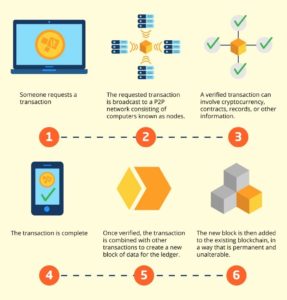
A blockchain, most simply, is a digital ledger. It can also be viewed as a chain of “blocks”, where each block contains information about recent transactions. Blocks are connected in chronological order where the first blocks are the oldest and this stream creates the digital register or ledger of transactions, deals, contracts, or anything which can be represented in digital form. Blockchains can be read and are available to anyone, which makes the log of transactions transparent. Transactions must be approved by everyone, which makes it impossible to disrupt or edit a historical block, or transactions, in the chain without everyone agreeing.
Blockchains can be used for just about anything as a tracking mechanism. For example, Walmart uses blockchain technology to manage its supply chain. With reference numbers, Walmart can track a bunch of spinach from where on a farm it was grown, when it was harvested, which truck carried it to which store, when it was put on the shelves and sold. In the event of a salmonella or listeria outbreak, Walmart knows exactly the origin and what other spinach could be contaminated to limit recalls to certain stores, or geographic areas rather than nationwide recalls. Truly innovative.
The most recent innovative way blockchains have been used are with digital asset accounting. Bitcoin, the largest digital asset, uses blockchain technology to log all its transactions. You can track each coin using the blockchain back to its origin. This is a public ledger of all the supply of Bitcoin available – everyone can see it, review it, verify it and trust it. When it comes to a currency or store of value, this is important because no one can increase the supply, or edit transactions in the past without everyone else agreeing. This blockchain technology is at the heart of what makes digital assets valuable and due to the wide range of possible use cases, may be here to stay.
Enter Bitcoin – a new digital Asset
The origin of Bitcoin dates to the Great Financial Crisis of 2008. A person or organization (the creator is unknown) under the pseudonym “Satoshi Nakamoto” published a white paper with the technical outline for a new, decentralized currency. The source code was released in January 2009 and the first block was mined, beginning what is today a nearly $1 trillion market cap asset class.
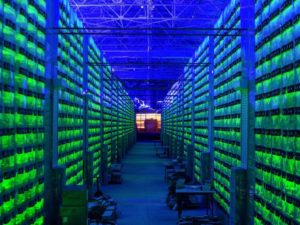 Since 2009, Bitcoin has been virtually “mined”, traded and transacted with or held for appreciation as a store of value. Over the last 10+ years, Bitcoin has been used for investments and currency, but also for illicit transactions and has been subject for exchange hacks and with millions of dollars lost, or unrecoverable forever. However, those that have properly bought, stored, or held the asset for long periods of time have made incredible returns on what was the best performing asset of the last decade.
Since 2009, Bitcoin has been virtually “mined”, traded and transacted with or held for appreciation as a store of value. Over the last 10+ years, Bitcoin has been used for investments and currency, but also for illicit transactions and has been subject for exchange hacks and with millions of dollars lost, or unrecoverable forever. However, those that have properly bought, stored, or held the asset for long periods of time have made incredible returns on what was the best performing asset of the last decade.
This is not to say there haven’t been bad times. Bitcoin has experienced extreme volatility, dropping over 80% on numerous occasions. If one loses 80% of their investment, that does not require an 80% gain to break even, but rather a 400% return to get back to even.
Bitcoin is unique due to its scarcity. There are only 21 million Bitcoin that will ever be created. Currently almost 19million of those 21 million have been created, with the rest scheduled for creation in the coming century. It is estimated that up to four million have been lost forever. Each Bitcoin can be split into 1/100,000,000th of a Bitcoin called “Satoshis” named after the creator, so it is possible to own a fraction of a Bitcoin
So How Does Bitcoin “Mining” Work?
As discussed earlier, Bitcoin’s “blockchain” is vital to its function. Blockchain technology is a public, distributed ledger of all prior transactions and those transactions are grouped into blocks that subsequently create a log of transactions dating back to the first transaction. The act of constructing and adding to the blockchain is called “mining”.
Super-computers run by groups and individuals around the world are responsible for solving complex algorithms and construct the blockchain and log of transactions that track each piece of Bitcoin. By securing this network, miners earn Bitcoin rewards for each block that is processed, therefore incentivizing people to continue strengthening and building the blockchain. The rewards of new Bitcoin are on a pre-set, deflationary schedule, which gets cut in half about every four years. The last Bitcoin will not be mined until 2140. The current rate of Bitcoin production is around 1.7%, making it less inflationary than gold and other stores of value. The computational power required is massive and growing, which is an environmental concern for some that will be discussed later.
In the early days of Bitcoin, when the rewards were much larger, many folks would use their home computers to mine Bitcoin while they sleep. Today, the power needed is not even worth the reward for most off the shelf computers or laptops. Much more energy and computational power is needed to help construct the blockchain now. Some mining companies are targeting unused power in innovative ways. Nuclear power can be harnessed from powerplants when the demand is low, such as in the middle of the night in what would otherwise be a waste of power. Oil drillers, often need to flare off natural gas biproduct, which is pollutive, however one company is targeting a way to harness that energy to mine Bitcoin, instead of pointlessly burning natural gas into our atmosphere.
How do you hold Bitcoin?
Bitcoin are stored in anonymous, digital wallets referenced by a series of numbers and letters and often a QR code, shown below. Wallets are secured by a passcode or “private key” which is a series of 24 random words. Wallets can send Bitcoin, much like wiring US Dollars, and those transactions are verified, added to the blockchain, and recorded for everyone to see. These peer reviewed transactions are less costly than a wire and almost instantaneous as there are no intermediary banks processing transactions. One of the largest transactions ever was a $1.15 billion transfer for the small cost of $3.58 which occurred and was verified in the recipient’s wallet in less than ten minutes.
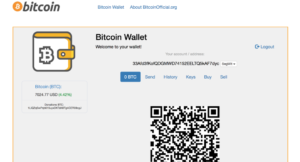
Bitcoin Gains in Popularity
Originally, interest was limited to speculators, individuals, niche trading firms, and investors. There was no public marketplace, or exchange to trade Bitcoins until 2011 and very few people accepted Bitcoin. The “Bitcoin Pizza” was the first known transaction of Bitcoin for goods, when someone spent 10,000 Bitcoin for two medium pizzas. Those Bitcoins today would be worth about $500million, but who’s counting?
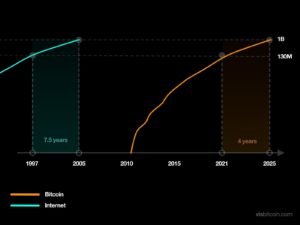 With each boom-and-bust cycle in price, Bitcoin garners more mainstream media attention, and with it more investors. It is estimated that over 100million people have bought Bitcoin which is just under 2% of the global population. Many have used Moore’s Law for adoption targets, and some expect that growth to be faster than internet adoption given it’s rise in popularity since its inception. Today for example, CNBC has a separate set of ticker categories for “Crypto Assets” on their home page. It is estimated that Bitcoin adoption, growing at its current rate, is equivalent to where the Internet was in 1997 and should reach 1Billion users faster than the internet did.
With each boom-and-bust cycle in price, Bitcoin garners more mainstream media attention, and with it more investors. It is estimated that over 100million people have bought Bitcoin which is just under 2% of the global population. Many have used Moore’s Law for adoption targets, and some expect that growth to be faster than internet adoption given it’s rise in popularity since its inception. Today for example, CNBC has a separate set of ticker categories for “Crypto Assets” on their home page. It is estimated that Bitcoin adoption, growing at its current rate, is equivalent to where the Internet was in 1997 and should reach 1Billion users faster than the internet did.
This is particularly interesting, and many are dubbing these innovative blockchain based digital assets and projects as Web 3.0. Web 1.0 and Web 2.0 refer to prior eras of the age of the internet. Web 1.0 refers to the internet period from 1991 to 2004 where most webpages were static, and most users were consumers rather than producers of content. Web 2.0 is based around the concept of the internet being used as a platform, leading to creation of social media, blogs, Wikipedia and marketplaces like Etsy or Amazon. Web 3.0 is the idea that by using public blockchains, companies, investments, securities and assets can be owned by the participants and decentralized. Ideas like DAO’s (discussed later) and investors having a say in the direction of the platforms rather than CEOs is the basis for blockchain and Web3.0.
Within the last few years, major revered and institutional investors have spoken out about Bitcoin and other digital assets.
- Bill Gates circa the 2017 boom said he would short Bitcoin if he could, however recently said he was not short the asset.
- Warren Buffet has called it a speculative bubble in the past, and recently doubled down on that comment saying it was “rat poison”.
- Jamie Dimon, CEO of JPMorgan, called it a speculative bubble as well in 2017, but JPMorgan recently put out a price forecast for fair value of over $140,000 per Bitcoin.
- Elon Musk has publicly expressed both appreciation for and the distrust of the digital asset on multiple occasions, adding to recent volatility. Tesla has gone so far as to include Bitcoin on its balance sheet and accept, for a short time, Bitcoin in exchange for Tesla cars.
- Fidelity Digital Assets recently put out a whitepaper citing Bitcoin as a valuable portfolio addition, citing that adding even 1% Bitcoin allocation to a portfolio has increased returns and diversification of a portfolio over the last 1, 2, 3 and 5 years.
- Prominent Hedge fund and Asset Managers have acknowledged Bitcoin as an effective “Store of Value” akin to Gold and publicly hold it in their funds. Paul Tudor Jones, Bill Miller and Stanley Druckenmiller and Ray Dalio are among them.
- Publicly traded Institutions are now adding the asset by investing their company treasury cash to some extent. Square, MicroStrategy, Metlife and aforementioned Tesla are a few of the higher profile companies.
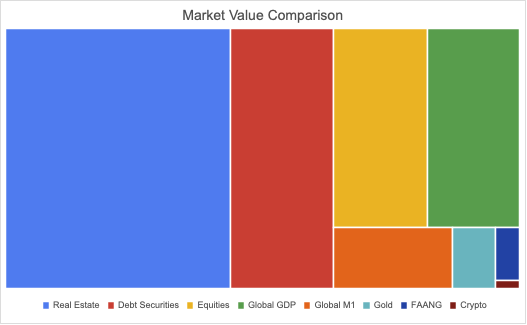
How Should Investors Value Bitcoin?
The intrinsic value of Bitcoin leaves much room for discussion. Who is to say that it is worth anything other than what those are willing to pay for it? Gold at least can be utilized for high-tech chip making and jewelry. Bitcoin has been the target of stock to flow modeling of late. Given the supply schedule is pre-determined and deflationary. It is even scheduled to have a lower inflation rate than gold in the future as the “Halving” events continue reducing the incoming supply of Bitcoin every four years.
If Bitcoin were to have the same market cap as gold, one Bitcoin would be worth approximately $500,000. Gold has about a $10 trillion market cap, whereas Bitcoin’s current market cap is around $1 trillion. At the same time, there is nothing preventing someone else from creating a better version of Bitcoin, rendering the current version worthless. There are many that believe the value is worth well more than just gold if it can become an effective means of transacting for goods and services or if mining gold from Asteroids becomes an easier task. This may sound farfetched, but it’s a legitimate cause for concern for the value of gold decades into the future.
The Good, Bad & Ugly of Bitcoin
For everything that Bitcoin is made out to be, there are some good and bad qualities which are worth mentioning in a boiled down manner. First the Good…
-
True Scarcity & Store of Value
There are only 21 million Bitcoin that can ever be created. Unlike Gold, which can be continuously mined (Elon Musk is discussing mining Gold from Asteroids), Bitcoin has a lower inflation rate than Gold, and it will continue to decline overtime. It is a truly, scarce asset, which some believe makes it more valuable than gold.
-
Decentralized
There is no government or central bank that can control or manipulate the quantity of the asset. With the additional stimulus due to COVID, many wonder about the unintended consequences.
-
Portability
Digital Wallets take up no space. Unlike Cash, Coins, Collectibles, Precious metals, which are not as portable as code on a piece of paper.
-
Divisibility
Bitcoins can be broken down into 100,000,000 fractions call a satoshis or “sats”. One “satoshi” is equal to about one twentieth of a penny ($0.0005).
-
Instant Transactions
Compared to big banks wiring funds, or trying to transfer gold around the world, Bitcoin can be transacted for fractions of what it would traditionally cost. One of the largest transactions ever was $1.15 billion for the small cost of $3.58 which occurred and was verified in the recipient’s wallet in less than ten minutes.
And the Bad…
-
High Price Volatility
The price swings are extremely volatile. The asset was worth $20,000 in December 2017. By January 2019, it was worth $3,000 and is now worth nearly $50,000 again. A “currency” should not have such volatile swings when being considered for transactions.
-
No Chargebacks or Refunds
Transactions are complicated and final. There is no way to get back Bitcoin if sent to the wrong wallet or recipient. This complicates transactions and stresses the importance of 100% accuracy, which is difficult.
-
Environmental Risks to Bitcoin Mining
Mining consumes a lot of energy. Especially in parts of the world, where less efficient, dirty coal power plants are producing that mining energy. Elon Musk has been vocal about this recently on twitter, suspending acceptance of Bitcoin as Payment for Teslas until at least 50% of mining uses renewable energy. It is estimated that securing the Bitcoin network uses the same energy as some whole countries, however this could be small when comparing it to the energy used by the big banks it aims to replace.
-
Potential to be replaced
A new Cryptocurrency could become a better option in the future. Today, Ethereum and other cryptocurrencies with more “tangible” use cases are becoming popular, so who is to say that Bitcoin, while first, won’t be the best option in the future.
-
Difficult to Transact
There are few merchants that accept Bitcoin currently. Starbucks for example cannot accept Bitcoin as currency for a cup of coffee. Tesla broke ground as one of the first major retailer to accept Bitcoin for its cars.
What about other digital assets?
-
Ethereum
Ethereum is the second largest digital asset based on market capitalization. Unlike Bitcoin, it is not a scarce asset, however it is far easier to transact with and its blockchain can be used to create other digital assets. Many offshoot lending platforms, exchanges, and projects have been created in what is being called Web3 or Web 3.0 and DeFi or Decentralized Finance. This ecosystem of companies and assets are separating themselves from the banking industry however the lack of regulation also brings rise to nefarious activities and projects where investors can lose money.
-
Stablecoins
Stablescoins are digital assets that are designed to be pegged to other assets most commonly fiat money. Tether is a US Dollar stablecoin that is meant to always be valued at or near $1. Some stablecoins are digital assets that are pegged to a treasury of other digital assets and fluctuate greatly. This space is being highly debated in congress, especially projects like Tether that are tied to US Dollars. Some custodians offer attractive interest rates on Stablecoins upwards of 8-9% APY, however there is more risk than meets the eye with these strategies.
-
NFTs
Non-Fungible Tokens have risen in popularity of late and are unique entries in the blockchain. The most common application is digital art. The owner of the art is visible to all on the blockchain. Skeptics are quick to point out that any public image, without the owner’s consent, can be saved and reprinted or duplicated. Mike Winkelmann, known professionally as Beeple, is one of the most well-known digital artists. He sold a piece in partnership with Christies that was a compilation of his first 5,000 days’ worth of art for $69.3 million dollars earlier this year. If you want to see the Mona Lisa, you need to visit the Louvre in Paris, however anyone can view this piece online. Beyond real, talended artists, are also algorithmically generated art. In the news lately are CryptoPunks, was a set of pixelated “punks” with different traits, some rare, some not. The base price of a punk today is north of $250,000.The use case for NFTs expands beyond art. For example, earlier this year, Kings of Leon, a famous band released their newest album as an NFT with different token levels pertaining to benefits for viewing shows, or first dibs at ticket sales.
-
Metaverse
One of the more peculiar uses cases of blockchain is the creation of the metaverse. Two of the larger providers of digital worlds are Sandbox and Decentraland. These are worlds that live on the blockchain where users can create an avatar and explore a virtual world. Using their currencies, users can buy outfits within the metaverse and even land. In December, a plot of digital land was sold for $2.43million within Decentraland which is more than most homes in NYC.
-
DAO – Decentralized Autonomous Organization
One of the major reasons to purchase digital assets is the lack of centralization. DAOs take this to a new meaning by dividing voting rights amongst token holders. If there are 100 Withum Wealth tokens and I hold 20 of them, I have 20% of the voting power for our organization. DAOs can be created with common goals or purposes. Some are to earn money, much like a VC fund, where holders can vote on how to invest the treasury of assets. Recently, ConstitutionDAO raised funds where people could contribute money with the goal of trying to purchase a highly rare copy of the US Constitution that went on auction last month.
-
And so much more
This only scratches the surface on some of the major digital assets in existence today but it is worth mentioning a few other digital assets exist as well. Solana, Avalanche and even satirical fake crypto currencies like Dogecoin have become popular for various reasons and no reasons at all. When Elon Musk joined the cash of SNL, they made jokes about his involvement with Dogecoin. Just as with businesses, anyone can create a digital asset if you have the tools.
 How Can Investors Acquire Digital Assets?
How Can Investors Acquire Digital Assets?
There are many ways, should one want exposure, to acquire or participate in Bitcoin or other digital assets as an investment. Given they are a completely different asset,there are myriad ways to participate.
-
Hold it with an Exchange or Custodian
Gemini and Coinbase are two of the largest US Custodians of digital assets, however they will hold your coins. You can move this out of the custodian’s possession and into your own wallet if you want, however there are often higher costs to entry because they facilitate the actual transaction and custody. Other exchanges exist with less reputation and backing but maybe have lower trading fees. These lower cost exchanges generally require more trading knowledge to get started. Square, Paypal and Venmo allow for purchases directly via their mobile apps. There are even peer-to-peer marketplaces online. One particularly interesting aspect of this is that Bitcoin has traded at massive premiums in countries of government distress like Venezuela and Nigeria.
-
Liquid Exchange Traded Products
Greyscale is a fund company that creates trusts that hold the underlying crypto currency, which trade on exchanges. It can trade at a premium or discount, given their ease of accessibility. The Greyscale Bitcoin Trust (GBTC) holds Bitcoin in the underlying trust. Each share of GBTC represents a small fraction of a Bitcoin held in trust, plus a premium or discount. Osprey Bitcoin Trust (OBTC) is another option with lower fees, but lower Bitcoin representation per share. It is far less liquid and has less assets under management. Interestingly, as the first competing product, this fund traded with a higher premium, despite the lower fee. Most of these products are currently trading at a discount for an unknown reason, meaning buying 1 share of GBTC is equivalent to buying only around 80% of the Bitcoin one would expect to purchase. Greyscale also has an Ethereum Trust (ETHE) as well as diversified Digital Asset trusts like their Large CapThis fall, several ETFs based on futures contracts were approved by the SEC. This should be contrasted with holding the underlying asset. With futures related ETFs, it costs money to continuously sell the current month contract and buy the new future contracts as time passes. This is costly and called “rolling” futures contracts. Currently there is an estimated 5-20% annual premium to do this, which would detract from returns. In the three months Proshares Bitcoin Strategy ETF (BITO) has been around, it has underperformed the price of Bitcoin at an annual rate of about 14%. Canada approved an ETF this spring, based on holding the underlying asset which solves this problem. They received $500mm in inflows in its first week. At that pace of growth, it has quickly become one of Canada’s largest ETFs. In the US, the SEC has not approved any physically backed Bitcoin ETFs.
-
The “Picks & Shovels” approach
Maybe the description gives it away, but most people don’t know that during the gold rush in 1849, the group that made the most money were not the gold miners, but rather those that sold supplies to the miners. Levi Strauss after learning from his brothers in New York, set off for San Francisco and started a wholesale dry good business of his own providing clothing (Jeans of course!), bedding, combs, purses, etc. to folks that were heading into the Sierras to look for gold. He amassed his fortunes not from mining gold but catering to those that did.This approach can be used with other digital assets as well. Due to the mining aspect of Bitcoin, owning stock in chip companies or publicly traded miners themselves could end up being a profitable way to participate in the movement, regardless of which asset becomes the lead in this movement.
In Conclusion
The digital asset space is a new frontier. It is unknown whether this is an innovative glimpse at the future of money, or just another fad still, but the possibilities are immense. Blockchain technology is sure to stay in many regards, but as with any financial information, this should not be used as a recommendation, but hopefully provided a good resource for knowledge and learning about this space.
Lastly, we recommend that you please consult your investment advisor for guidance on whether to add Bitcoin, Ethereum or NFTs to your own portfolio and use caution with any investment that is unregulated. This depends on your investment time horizon and risk. Proper diversification would say that no single asset should ever make up more than 5% of one’s liquid net worth to mitigate risk if the asset goes to zero.


